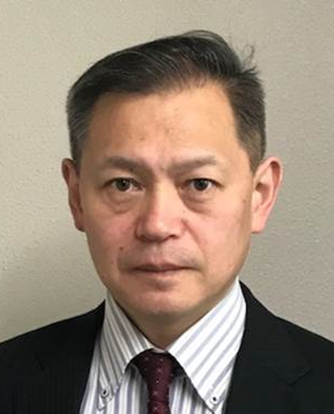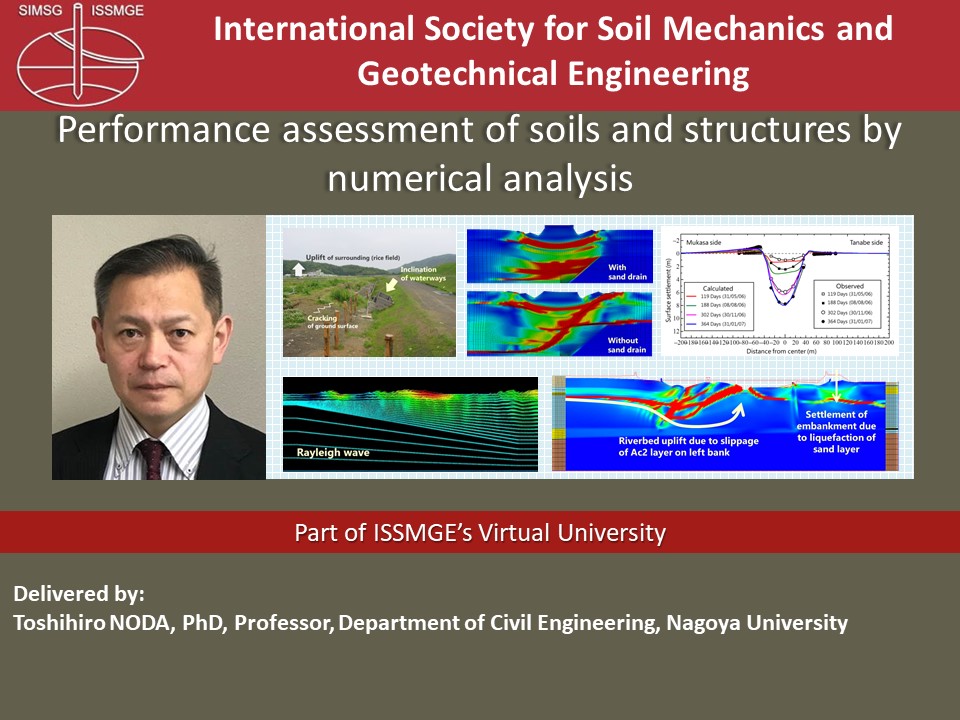About This Course
This course presents examples of performance assessment of soils and structures in quasi-static / dynamic problems. The assessments were performed using a soil-water coupled and elasto-plastic finite deformation analysis code developed by the presenter’s geomechanics research group.
This webinar is broadly divided into two parts.
I. Background & formulations (constitutive modelling & coupling finite deformation analysis)
The first part is on the concept of what I want to explain regarding the subject of “performance assessment for soils and structures”.
(1) Background (Insight of current scenario) & Objectives (Problem presentation & solution)
The background and objectives of our geomechanics research group are presented along with the insight of the current scenario of this subject, particularly in Japan, as well as the problem statement and its possible solution. Subsequently, the extreme subdivision of the existing numerical analysis tools necessary for solving geotechnical problems is discussed. I also describe the theory and/or analysis tool aimed for, whose architecture can be compared to an Engine and a Chassis of a car.
(2) Outline of Engine (elasto-plastic constitutive model)
The engine represents an elasto-plastic constitutive model. It should describe the mechanical behavior with material nonlinearity of a wide variety of soils, from clay to sand through intermediate soils, consistently within the same theoretical framework. Therefore, the prerequisites of the constitutive model developed by our research group, namely the SYS Cam-clay model, are introduced. They are compared with the well-known Cam-clay model as a basic model. Moreover, examples of the possible behaviors described by the SYS Cam-clay model are presented.
(3) Outline of Chassis (Soil–water coupled finite deformation analysis)
The Chassis corresponds to continuum mechanics based on mixture theory, that is, soil-water coupled finite deformation analysis. The deformation analysis should describe the mechanical behavior due to the geometrical non-linearity, that is, effect of the change in the geometry. From this point of view, I show the formulation of the governing equations for the analysis as well as present a simple problem to emphasize the importance of the effect of change in geometry.
II. Analytical examples for quasi-static & dynamic problems
The second part of this webinar focuses on the examples of soft soil engineering problems in Japan, as quasi-static and dynamic problems, to which the analysis tool was applied. Based on these examples, I show the necessary geotechnical tools for the performance assessment of soils and structures from the viewpoints of unconventional and computational geomechanics.
(4) Static problem: Deformation to failure of soil
As for the quasi-static problems, an evaluation example is shown, in which a large deformation was targeted from deformation to failure of an ultrasoft soil comprising peat. At the start of our evaluation, a settlement of more than 10 m had already occurred on an embankment constructed on the soft soil of an expressway. Therefore, the prediction of future settlement, and examination of the countermeasures against large settlement are required.
(5) Dynamic problems: seismic performance evaluation
In regard to the dynamic problems, as you might know, Japan is an earthquake-prone country, and, indeed some big earthquakes have occurred in the past thirty years. These earthquakes caused devastating damages to the ground and soil structure as well as to buildings, bridges, and other structures. Therefore, I show two numerical examples of an artificial ground and a river levee on a soft ground.
The 2011 Great East Japan Earthquake of Mw 9.0 caused a wide range of liquefaction of more than 40 km2 around Tokyo Bay, which was even approximately 400 km away from the epicenter. In this webinar, I discuss why such an earthquake motion caused severe liquefaction damage to artificial grounds.
Also, the Nankai trough subduction earthquake is expected to shortly hit the Tokai region. There are wide areas below sea level in the alluvial plains surrounded by river and coastal levee protections. As a second example, the seismic evaluation results for a river levee constructed on sand-clay laminated ground are shown.
These dynamic problems include rather new topics such as the damage due to the edge effect of the seismic motion resulting from the interference of direct body waves and basin-induced surface waves, and dynamic behavior of ultrasoft clay.
(6) Summary with short numerical examples
I conclude with a summary and some additional simple numerical examples.



![Decompose, Recompose: Useful approaches for the design of geotechnical structures (in French) {"category":"webinar","subjects":["Soil Structure Interaction", "Foundation Design/Construction", "Numerical and Constitutive Modelling"],"number":"CFMS-02","instructors":["Bruno Simon"]}](/asset-v1:ISSMGE+CFMS-02+2025+type@asset+block@webinar2.png)
![Zelazny Most Copper Tailings Depository Numerical Analysis of Deep Vertical Shafts (First Tschebotarioff Lecture) {"category":"honour_lecture","subjects":["Mining", "Numerical and Constitutive Modelling"],"number":"HTL101","instructors":["Michele Jamiolkowski"]}](/asset-v1:ISSMGE+HTL101+2014+type@asset+block@htl101.jpg)
![Modelling and Testing (Bishop Lecture - 19th ICSMGE) {"category":"honour_lecture","subjects":["Laboratory Testing", "Numerical and Constitutive Modelling"],"number":"ICSMGE102","instructors":["David Muir Wood"]}](/asset-v1:ISSMGE+ICSMGE102+2017+type@asset+block@bishop-lecture.jpg)
![Numerical modelling in Geomechanics {"category":"webinar","subjects":["Numerical and Constitutive Modelling"],"number":"TC103-03","instructors":["T. Noda","H. Schweigher","F. Nicot","J. McCartney"]}](/asset-v1:ISSMGE+NM101+2022+type@asset+block@numerical-modelling-geomechanics.jpg)
![An Introduction to Numerical Modelling in Geotechnical Engineering {"category":"webinar","subjects":["Numerical and Constitutive Modelling"],"number":"NSM101","instructors":["Helmut F. Schweiger"]}](/asset-v1:ISSMGE+NSM101+2017+type@asset+block@Schweiger-Intro.jpg)
![Introduction to Slope Engineering {"category":"course","subjects":["Numerical and Constitutive Modelling","Soil Mechanics","Slope Stability"],"number":"GEE2020-1","instructors":["Wu Shunchuan"]}](/asset-v1:ISSMGE+SE101+2023+type@asset+block@intro-slide.jpg)
![From Discrete to Continuum: Multiscale Approach of Failure in Geomaterials {"category":"webinar","subjects":["Numerical and Constitutive Modelling"],"number":"TC103-01","instructors":["Francois Nicot"]}](/asset-v1:ISSMGE+TC103-01+2021+type@asset+block@Nicot-cover.jpg)
![Numerical Simulations on Energy Piles {"category":"webinar","subjects":["Numerical and Constitutive Modelling"],"number":"TC103-02","instructors":["John McCartney"]}](/asset-v1:ISSMGE+TC103-02+2021+type@asset+block@Screenshot_2024-05-14_143023.png)
![Numerical Simulation of Soft Soil Improvement Using Prefabricated Vertical Drains and Preloading {"category":"webinar","subjects":["Numerical and Constitutive Modelling"],"number":"TC103-04","instructors":["Ali Parsa-Pajouh"]}](/asset-v1:ISSMGE+TC103-04+2025+type@asset+block@photo.png)
![Risk-Mitigation, Monitoring & Observational Methods {"category":"course","subjects":["Risk and Reliability","Foundation Design Construction","Leeves","Erosion","Instrumentation","Landslides","Deep Excavations","Earth Retaining Structures","Numerical and Constitutive Modelling"],"number":"VU-RMOM","instructors":["Jean-Louis Briaud","Zenon Medina-Cetina","Marco Uzielli","An Bing Huang","Marc Ballouz"]}](/asset-v1:ISSMGE+VU-002+2016+type@asset+block@ballouz-webinar.jpg)